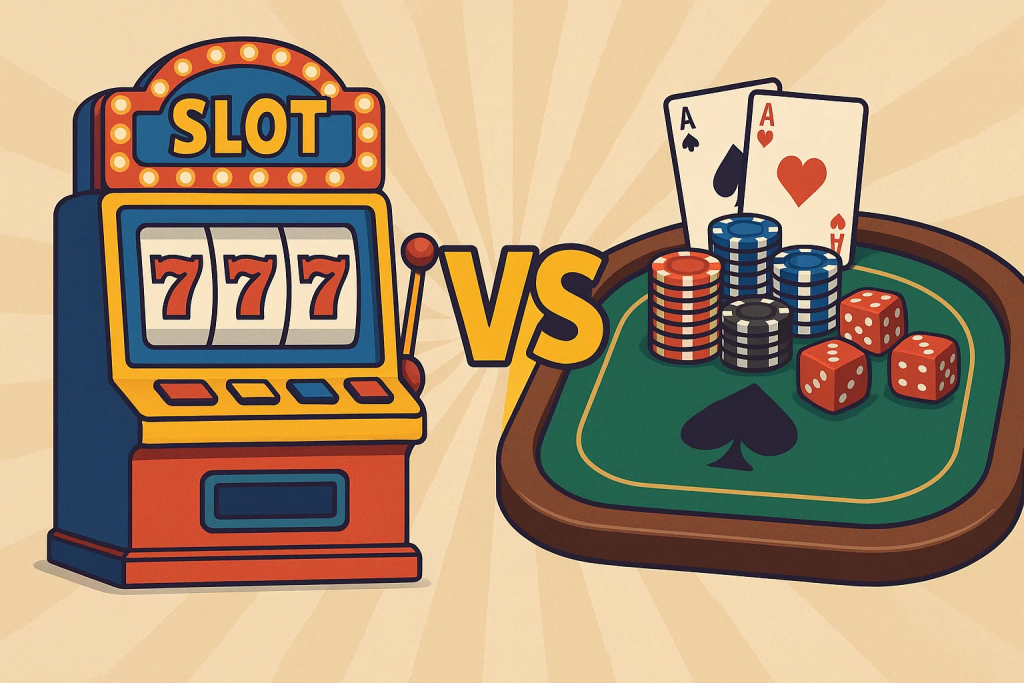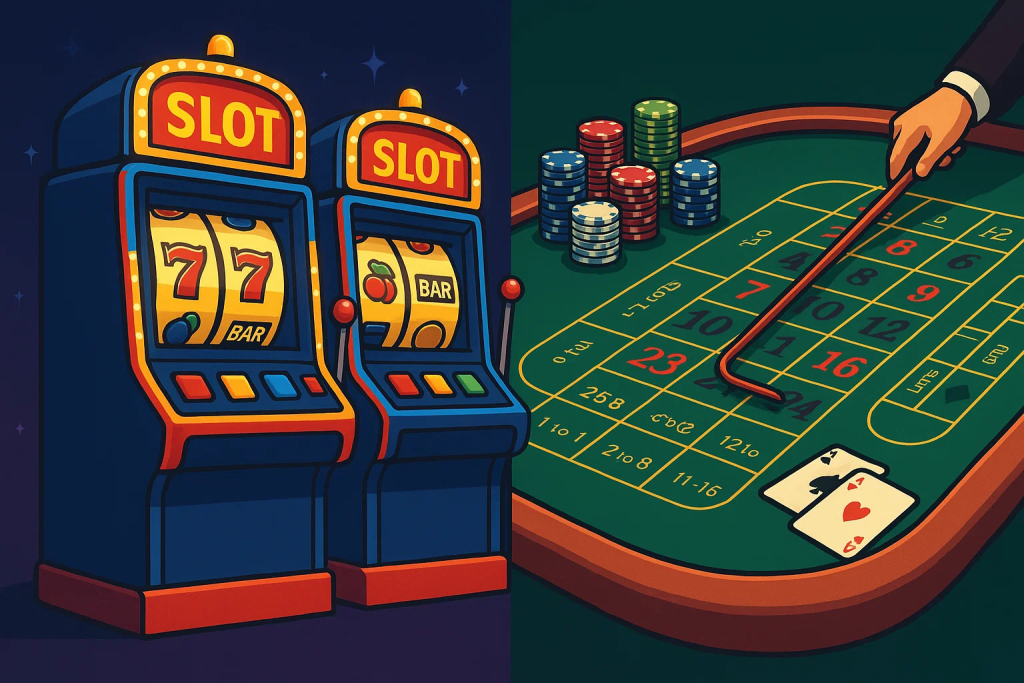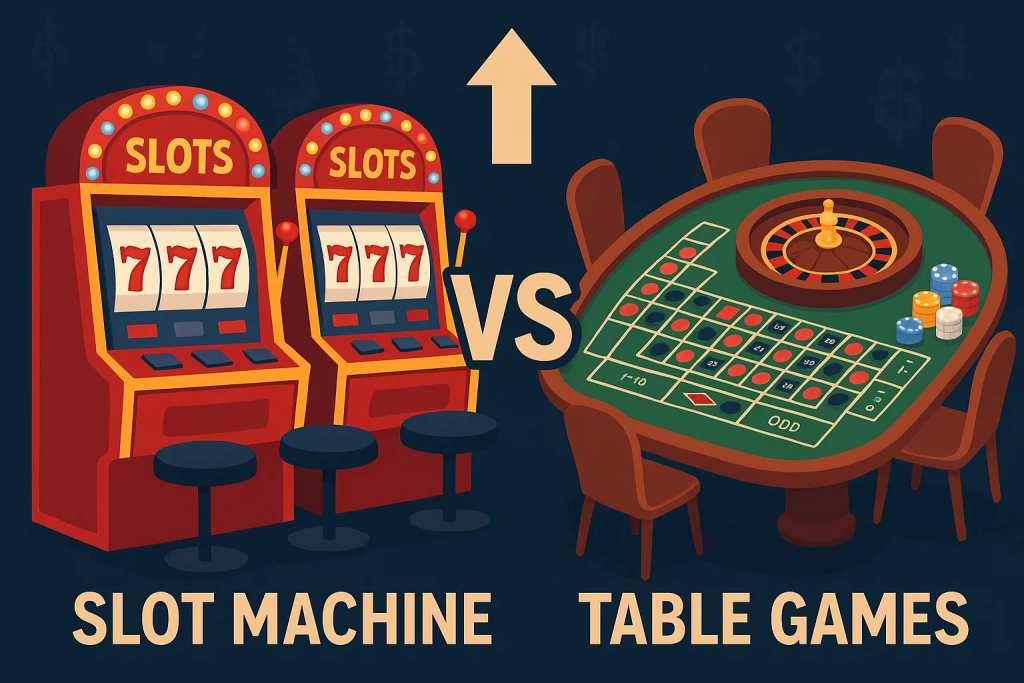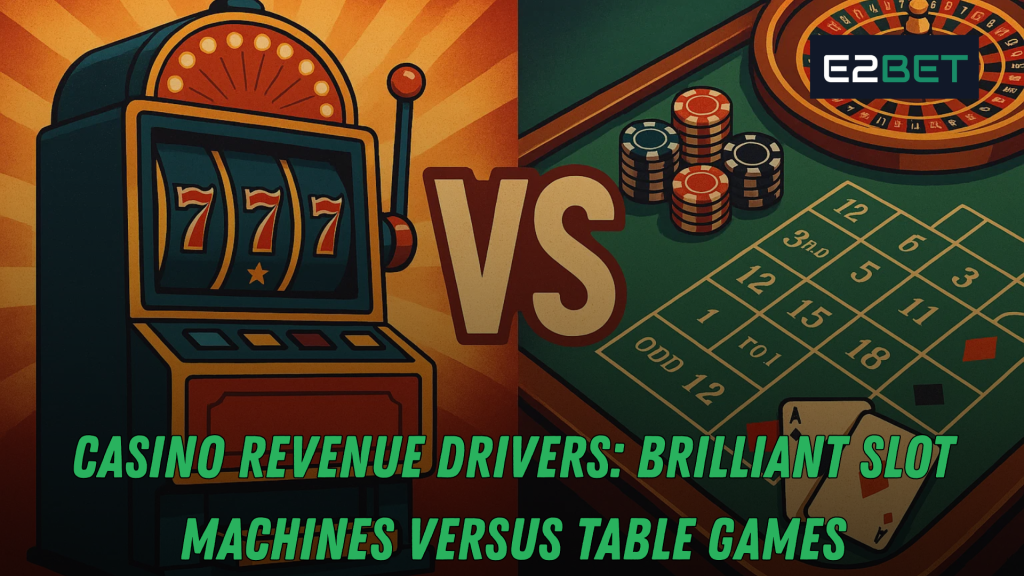Table of Contents
What Really Drives Profit in Modern Casinos
Casino Revenue Drivers: In competitive gaming destinations, management teams constantly ask a practical question: which product mix reliably grows profit—fast-paced slots or sociable, high-limit tables? The accurate answer is that both matter, but they contribute differently to guest experience, volatility, and casino revenue. This long-form guide explains the mechanics behind margins, the KPIs executives should really track, and how to design a floor that compounds return without compromising responsible play. Whether you run a regional property or a flagship resort, you will find a decision framework to tune product strategy, guest journey design, and data discipline.

The Language of Revenue: Terms That Matter
Before debating slots vs tables, align on definitions. Handle or coin-in describes total money cycled through slot machines. Drop is the cash or chips accepted at a table. Hold percentage expresses the share of handle or drop that remains with the house. Theoretical win (often shortened to “theo”) estimates expected performance given game rules, pace, and average bet. Win per unit per day benchmarks individual device or table productivity. When leaders standardize these terms, they can compare apples to apples and diagnose whether changes help or hurt casino revenue.
Why Slots Often Dominate the P&L
Across many markets, slots provide steadier contribution because they require less labor, present simpler onboarding, and allow flexible configuration. Pace is a hidden superpower: hundreds of rounds per hour compound small edges into meaningful totals. Modern loyalty systems also capture precise behavior, so pricing, placement, and offers can be tuned quickly. The cumulative effect is resilient casino revenue, especially on midweek days when table volumes are thin. When teams space banks intelligently, rotate themes, and keep uptime high, slots deliver predictable throughput that anchors the month’s plan.
When Table Games Lead the Story
Table games shine in peak periods, hosted weekends, and markets that love baccarat or blackjack rituals. Average wager sizes can surge, and the social atmosphere lifts non-gaming spending on dining, nightlife, and retail. Trained dealers increase hands per hour, while thoughtful minimums let managers shape demand. With the right event calendar, tables can produce breakout days that reshape monthly results. The operational caveat is volatility: a few VIP outcomes can swing results, so governance and bankroll management are essential to protect casino revenue while still honoring guest experience.
Slots vs Tables: Economics at a Glance
- Labor model: Slots rely on technicians and attendants; tables require dealers, supervisors, and surveillance depth. The difference influences variable costs and therefore net casino revenue.
- Footprint and scaling: Adding a machine is straightforward; adding a pit consumes space and staffing. Scaling strategy should favor the format that lifts marginal casino revenue with minimal complexity.
- Volatility profile: Slots smooth results through pace and volume; tables deliver higher peaks and deeper valleys. A balanced blend stabilizes weekly and monthly casino revenue.
- Data richness: Loyalty cards and system telemetry make slots highly measurable; rating systems are improving for tables, but segmentation is still maturing. Better measurement means more accurate forecasting of casino revenue.
Designing a Floor That Compounds Results
Think in zones, not random rows. Place progressive links and headline cabinets where sightlines converge. Surround them with comfortable, lower-denomination banks that extend time-on-device. Nearby, stage a flagship pit with high visibility and clear pathways to premium bars. Each zone should have a job: attract, engage, or convert. When zones work as a system, circulation improves, dwell time increases, and incremental spend flows into stable casino revenue. Add wayfinding, lighting, and acoustics that encourage comfort and give novices the confidence to try new games.
Pricing, Minimums, and Perceived Fairness
Guests feel price through denomination, paytable clarity, and table minimums. Managers influence demand by moving minimums up during peaks and down during lulls, by offering side bets strategically, and by configuring slot volatility to match audience appetite. The art is managing perception so guests feel entertained and respected while the property sustains healthy casino revenue. Publish clear rules, train front-line staff to explain changes with empathy, and monitor feedback loops; transparency pays back through long-term loyalty.
Loyalty, Hosts, and the Trip Lifecycle
A compelling program turns casual guests into advocates. Use tiers to signal progress, but reward behavior that predicts lifetime value—not just one-night spikes. Integrate hosts with digital channels so offers arrive at the right time with realistic expiries. Mix gaming with memorable experiences—chef tables, shows, or spa packages—so trips feel complete. The objective is a predictable cadence of visits that sustains baseline casino revenue. When loyalty data guides scheduling, staffing, and marketing rhythm, fewer surprises appear in month-end reconciliations.
Hybrids and ETGs: Bridging Two Worlds
Electronic table games and stadium formats blend the social cues of live dealing with the efficiency of machines. They absorb overflow during peaks, lower intimidation for beginners, and run with leaner staffing. For properties that struggle to staff pits or want to stretch capacity, ETGs can smooth demand, lift hands per hour, and contribute consistent casino revenue. The trick is placement: align ETGs near live tables so energy transfers; use signage and ambassadors to onboard new players; and track whether ETGs expand the funnel rather than cannibalize live play.
Content Refresh and Floor Velocity
Stale content is silent shrinkage. Rotate underperforming banks, test new math models, and retire cabinets that no longer earn their footprint. Establish a 90- to 120-day review cycle with scorecards that combine performance, guest feedback, and maintenance cost. Promote “what’s new” so regulars have reasons to explore. Freshness increases trial and protects long-term casino revenue. With tables, consider seasonal side bets, themed events, and dealer training that improves pace; an extra few hands per hour compounds quickly.
Non-Gaming Spend and Cross-Sell
Guests rarely silo their trips. Dining, nightlife, retail, and entertainment all interact with the gaming core. Use reservation data to stagger play and meal windows; offer packages that bundle show tickets with match-play or slot free play. When executed thoughtfully, cross-sell raises trip satisfaction and average check while reinforcing casino revenue. Measure cannibalization carefully: the goal is not to trade gaming dollars for restaurants, but to lift total wallet through better pacing and experiences that stretch the stay.
KPIs Leaders Should Watch Weekly
- Win per unit per day by zone and product family.
- Occupancy by hour to reveal hidden peaks and troughs.
- Average bet and hands per hour by table type.
- Uptime and fault codes on top slot banks.
- Offer response rate segmented by tier and visit recency.
- Guest satisfaction with particular attention to first-time visitors.
These metrics tell a story about capacity, pricing, and execution, allowing teams to forecast and defend casino revenue. If dashboards are clean and shared, middle management can fix issues before the month is lost, protecting baseline casino revenue.
Responsible Play Is a Business Strategy
Sustainable revenue assumes healthy guests. Train teams to recognize fatigue and frustration, provide voluntary limits, and promote breaks that include shows, spa, or outdoor time. Slot design should emphasize clear paytables and session clocks; pits should empower supervisors to slow minimums when energy dips. Properties that champion guest well-being earn trust and repeat visitation—the foundation of predictable casino revenue. Over time, a reputation for fairness and care becomes a moat that rivals cannot easily copy.
Variance, Bankroll, and Risk Management
Table volatility can elevate results or challenge a month. Set spread limits, deploy countermeasures to advantage play, and ensure marker controls are enforced. For slots, diversify math models to balance entertainment and edge. Finance teams should maintain rolling forecasts that model downside scenarios and fund reserves accordingly. Smart limits do not dampen fun; they protect the floor and the brand while keeping outcomes within tolerances that preserve casino revenue. The goal is smooth sailing rather than heroics.
Data, Privacy, and Personalization
Guests will trade data for real benefits if you treat their information with respect. Collect only what you need, secure it, and explain how it improves the visit. Use predictive models to time offers, seat reservations, and match amenities to preferences. Personalization can lift conversion dramatically without heavy discounting, which means more efficient marketing spend and steadier casino revenue. If consent management is transparent, loyalty grows organically, and that loyalty compounds into resilient casino revenue even when competition heats up.
Scenario Playbook: Three Common Challenges
- Midweek softness: Shift promotions toward experiences and comfort. Expand penny and low-denom banks that extend session length. Result: smoother traffic and stickier casino revenue.
- Peak-hour congestion: Raise table minimums in defined windows and encourage overflow to ETGs. Pre-book dining through hosts to avoid lines. Effect: higher average bet and protected casino revenue.
- Aging slot library: Replace the bottom quartile with fresh themes and progressive links. Train staff to demo features. Outcome: trial increases and floor-wide casino revenue rises within weeks.

Marketing That Respects Math
Hype without math erodes value. Build campaigns around calendars and capacity, not random hype cycles. Promote what the floor can actually support, then measure redemption and displacement. For example, target new-to-brand guests with tutorial nights at tables and easy-to-learn ETGs, while rewarding loyal slot players with early access to headline cabinets. When messages match experience, word-of-mouth improves, acquisition costs fall, and marketing spend converts to durable casino revenue. The best promotion is a great visit that people retell.
Tech Stack Priorities for Operations
Focus on systems that shorten feedback loops: floor analytics, slot accounting, pit rating, offer orchestration, and mobile wallets. Integrations matter more than feature lists; if data does not flow, insights die in silos. Equip managers with live heatmaps and staffing tools so they can adjust in the moment. A nimble stack replaces drama with cadence, and that cadence steadily grows casino revenue. Over time, the organization becomes more predictable, which reduces surprises and improves investor confidence tied to casino revenue.
People, Training, and Culture
Service is strategy. Empower attendants, dealers, and hosts to solve small problems without escalation. Recognize pace, friendliness, and accuracy publicly. Rotate teams through cross-training so they understand how slots and tables support one another. A respected frontline delivers fewer errors, faster recoveries, and warmer experiences—inputs that translate into stronger casino revenue. Culture is not a poster; it is a habit system that shows up on the floor, day after day, and quietly compounds casino revenue while competitors chase gimmicks.
Financial Governance and Capital Discipline
Capex should follow a portfolio logic. Model expected returns by zone, not by vendor hype. Require pilots before full roll-outs; protect maintenance budgets for top-earning assets; and sunset pet projects that do not move the needle. Present clear scorecards to boards that connect guest outcomes to financial trajectories. When governance is boring—in the best way—execution shines, risk shrinks, and steady casino revenue becomes normal. The business then funds innovation from strength rather than reacting to emergencies.
The Future: Cashless, Personal, and Friction-Light
Cashless wallets, real-time offers, and smarter wayfinding will reduce friction. Expect more blended experiences where guests transition from play to dining to shows without breaking flow. As personalization matures, properties will win not by being louder but by being easier. Ease converts into time on device or at table, and time converts into sustainable casino revenue. The next decade will reward operators who pair empathy with analytics, crafting spaces where relaxation and excitement coexist, quietly compounding value.
Call to Action: Audit, Align, and Act
Block 90 minutes with your leadership team this week. Map zones, review KPIs, and list three friction points that annoy guests most. Assign owners and deadlines. Ask hosts and frontline staff what they need to move faster. Then schedule a follow-up in thirty days to quantify impact on casino revenue. Progress happens when teams audit honestly, align on simple priorities, and act without waiting for perfect certainty. The sooner you start, the sooner you build momentum—and momentum is the ally of durable casino revenue.
Deep Dive: The Math Behind Margins
Strategy gets real when the numbers do. For slots, think in cycles: denomination, average wager, spins per hour, and hold. Small changes compound—raising average bet by just a few cents, or lifting spins per hour through better ergonomics, can materially increase casino revenue. For tables, the critical levers are hands per hour, average wager, side-bet uptake, and minimums during peak windows. Model sensitivity on a simple spreadsheet: test one change at a time and measure effect size on daily casino revenue. Then simulate the week and month so teams see how operational tweaks pay off.
Do not stop at device math. Layer guest lifetime value to prioritize capital. If a cabinet attracts new members who return within sixty days, it may be worth more than a slightly higher daily win. Similarly, a blackjack tutorial night that converts beginners into confident players could increase repeat visitation and lift long-horizon casino revenue. Measure acquisition cost against likely retention and you will make smarter choices about vendors, themes, and event budgets.
Finally, track variance honestly. A hot run at a high-limit table can distort perceptions for weeks. Weekly reviews should separate signal from noise so you do not chase ghosts. Discipline improves forecasts and keeps managers focused on controllable inputs that steadily grow casino revenue.
A 12-Month Roadmap to Optimize Mix and Experience
Quarter 1: Audit and Quick Wins
- Map every zone and rank by win per unit per day.
- Identify the bottom quartile of slots and pilot two new themes.
- Add sign-posted tutorials at two table types to reduce intimidation.
- Publish a service playbook so frontline staff can fix common issues on the spot.
- Set a baseline dashboard for casino revenue.
Quarter 2: Placement and Pricing
- Rebank headline games into high-sightline locations; relocate underperformers.
- Test minimums during defined peaks and evaluate guest feedback.
- Expand ETG capacity to soak overflow.
- Coordinate dining and entertainment with your hosts’ calendar.
- Track the effect on trip satisfaction and casino revenue.
Quarter 3: Personalization and Partnerships
- Launch tailored offers that match preferences gathered from loyalty data.
- Partner with local chefs or artists to create must-see weekends.
- Equip hosts with mobile tools so they can adjust itineraries in real time.
- Measure coupon liability against incremental lift to verify net positive casino revenue.
Quarter 4: Capital and Culture
- Lock in capex for next year based on zone performance, not vendor hype.
- Deepen training for dealers and attendants with pace, clarity, and empathy drills.
- Celebrate wins publicly so teams feel the connection between service and casino revenue.
- Publish a year-end review that links guest stories to key movements in casino revenue.
Common Mistakes—and How to Fix Them
- Over-theming without math: New art cannot rescue weak performance. Demand a business case that ties aesthetics to measurable casino revenue.
- Ignoring dwell time frictions: Long lines, poor signage, and cold queues push guests away. Remove friction first; smoother flow lifts casino revenue.
- Chasing whales at all costs: VIP volatility can whipsaw results and morale. Build a stable base with consistent mid-market play so peaks add to, rather than define, monthly casino revenue.
Conclusion: Balance, Clarity, and Care
In the slots-versus-tables debate, the answer is balance. Use data to design zones, price with empathy, and refresh content before it goes stale. Train people to solve problems quickly, and treat well-being as part of the product. When every department sees how its daily actions link to casino revenue, the organization moves in rhythm. Over time, small, steady improvements outcompete sporadic big bets, and guest trust becomes your greatest asset supporting durable casino revenue.
Casino VIP Brilliant Strategy: Personal Hosts & Concierge Service
Benchmarking and External Factors
Context matters. Weather, airline schedules, and competing events can swing results, so compare like with like. Build a simple benchmark pack that shows year-over-year and week-over-week performance by zone, controlling for unusual events. Use competitor scans to understand placement and pricing changes, but avoid reactive copying—what works across town may not fit your guests. The purpose of benchmarking is clarity: learn faster so the team can protect casino revenue during soft patches and amplify momentum during favorable cycles.

Remember that marketing noise without operational capacity creates disappointment. Confirm staffing, inventory, and maintenance windows before launching big moments. After each campaign, run a forensic review: did traffic, time on device, and spend patterns translate into stronger casino revenue? Keep a small list of high-confidence plays and retire low-yield ideas swiftly so every quarter edges casino revenue upward.
Postscript: Share this guide with your team and revisit it each quarter for discipline.
Frequently Asked Questions
1) Which product usually contributes more to revenue?
In many regional markets, slots provide steadier contribution thanks to pace, data, and lower labor needs. However, strong table programs can dominate during peaks or in baccarat-heavy geographies. The smartest operators blend formats to stabilize casino revenue.
2) How often should we refresh slot content?
Review performance quarterly and rotate the bottom quartile. Promote the “new” aggressively for two weeks, then watch trial and time-on-device. A disciplined refresh cycle protects casino revenue.
3) What minimums make sense on busy nights?
Let data guide adjustments. Raise minimums in defined windows, communicate clearly, and track drop and satisfaction. Right-sizing minimums captures demand without harming long-term casino revenue.
4) Do ETGs cannibalize live tables?
Results vary by market. Many properties find ETGs expand the funnel by onboarding new players and absorbing overflow. Test placement and watch whether total casino revenue rises rather than just shifts.
5) How do we talk about responsible play without scaring guests?
Normalize breaks, offer limits, and design experiences beyond the floor. Caring language, not lectures, builds trust and repeat visits. Trust is the foundation of healthy casino revenue.
